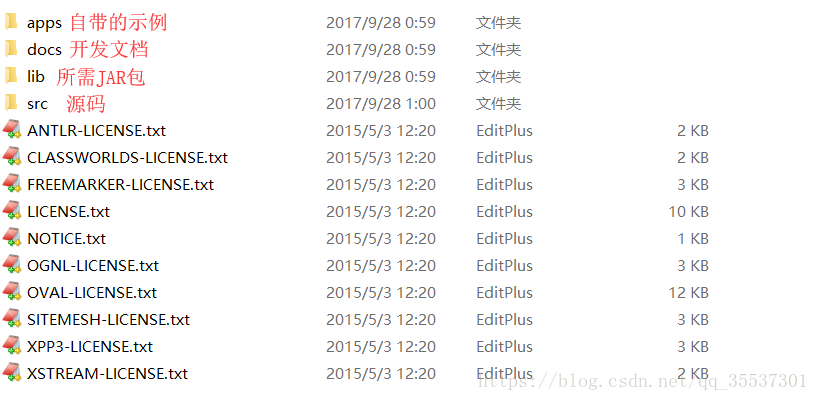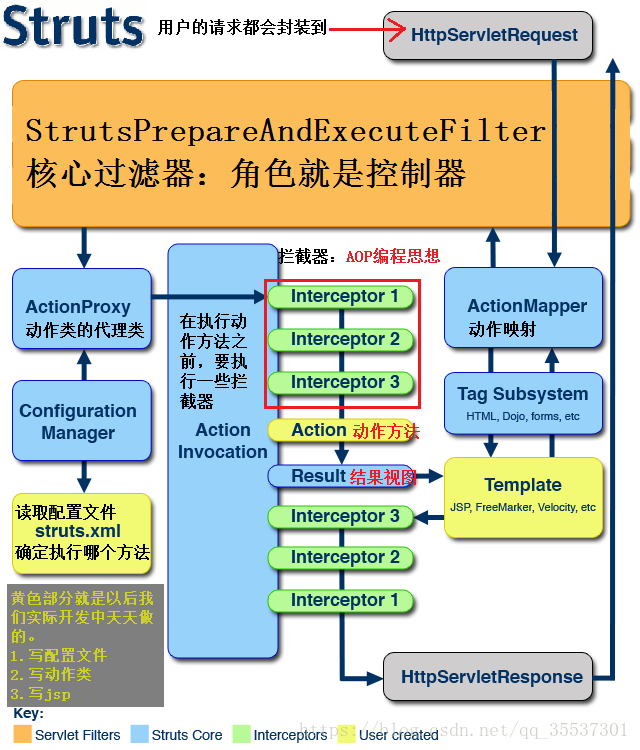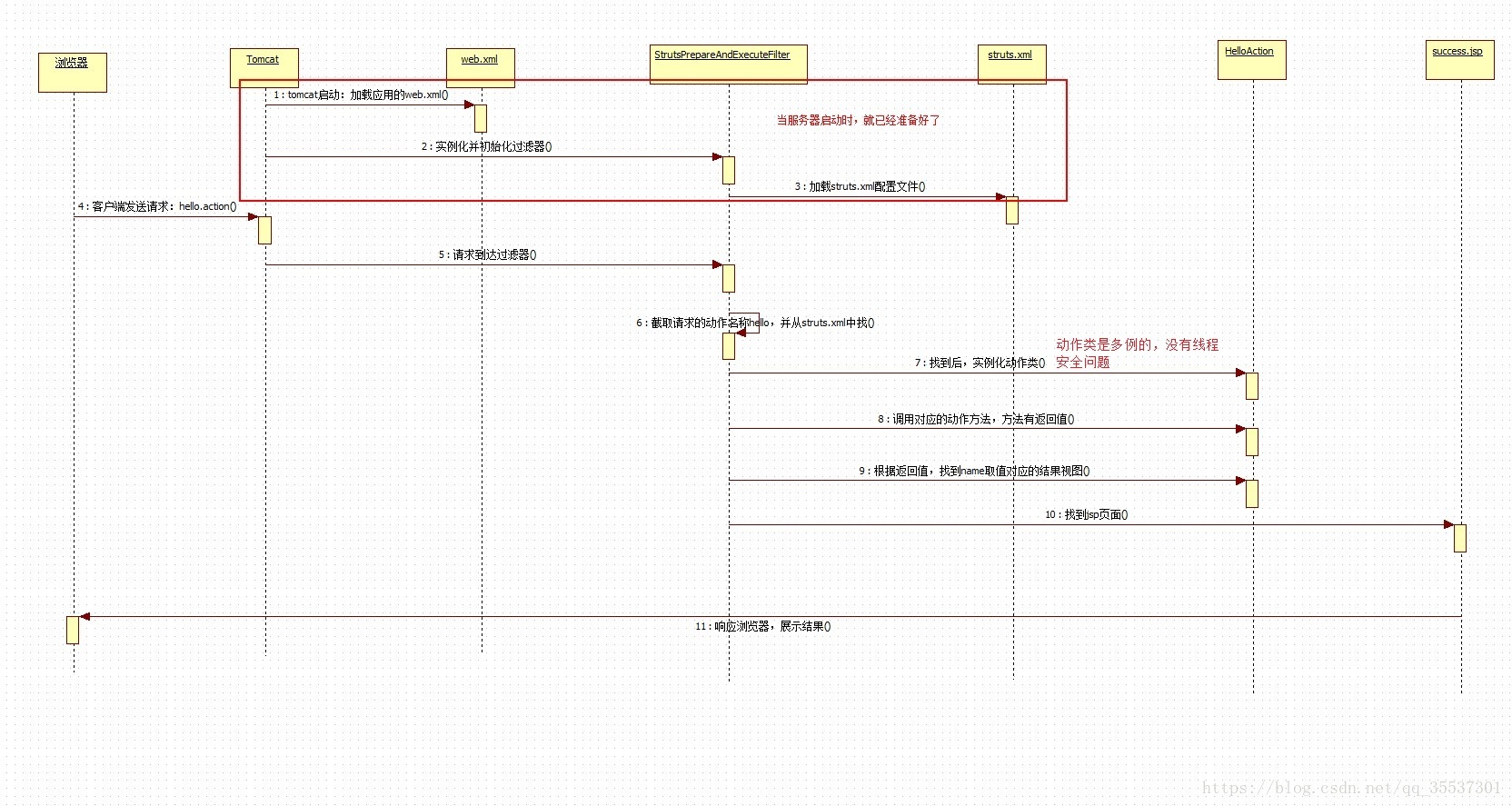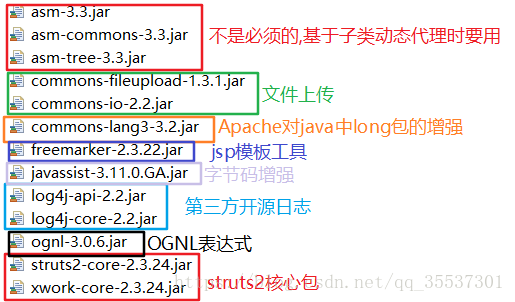struts2开发包

入门案例所需jar包
入门案例步骤
创建项目,导入jar包

创建核心配置文件,添加约束

在SRC下,创建struts.xml文件
<?xml version="1.0" encoding="UTF-8"?>
<!DOCTYPE struts PUBLIC
"-//Apache Software Foundation//DTD Struts Configuration 2.3//EN"
"http://struts.apache.org/dtds/struts-2.3.dtd">
<struts>
</struts>在web.xml中配置struts2核心过滤器
<?xml version="1.0" encoding="UTF-8"?>
<web-app xmlns:xsi="http://www.w3.org/2001/XMLSchema-instance"
xmlns="http://java.sun.com/xml/ns/javaee"
xsi:schemaLocation="http://java.sun.com/xml/ns/javaee http://java.sun.com/xml/ns/javaee/web-app_2_5.xsd"
id="WebApp_ID" version="2.5">
<display-name>struts2_day01</display-name>
<welcome-file-list>
<welcome-file>index.html</welcome-file>
<welcome-file>index.htm</welcome-file>
<welcome-file>index.jsp</welcome-file>
<welcome-file>default.html</welcome-file>
<welcome-file>default.htm</welcome-file>
<welcome-file>default.jsp</welcome-file>
</welcome-file-list>
<!-- 配置struts2核心过滤器 -->
<filter>
<filter-name>struts</filter-name>
<filter-class>org.apache.struts2.dispatcher.ng.filter.StrutsPrepareAndExecuteFilter</filter-class>
</filter>
<filter-mapping>
<filter-name>struts</filter-name>
<url-pattern>/*</url-pattern>
</filter-mapping>
</web-app>编写页面
hello.jsp
<%@ page language="java" contentType="text/html; charset=UTF-8"
pageEncoding="UTF-8"%>
<!DOCTYPE html PUBLIC "-//W3C//DTD HTML 4.01 Transitional//EN" "http://www.w3.org/TR/html4/loose.dtd">
<html>
<head>
<meta http-equiv="Content-Type" content="text/html; charset=UTF-8">
<title>Insert title here</title>
</head>
<body>
<h1>成功</h1>
</body>
</html>success.jsp
<%@ page language="java" contentType="text/html; charset=UTF-8"
pageEncoding="UTF-8"%>
<!DOCTYPE html PUBLIC "-//W3C//DTD HTML 4.01 Transitional//EN" "http://www.w3.org/TR/html4/loose.dtd">
<html>
<head>
<meta http-equiv="Content-Type" content="text/html; charset=UTF-8">
<title>Insert title here</title>
</head>
<body>
<h1>Struts2的入门</h1>
<a href="${ pageContext.request.contextPath }/aaa/helloStruts.action">Struts2的入门的访问路径</a>
</body>
</html>
编写核心配置文件
<?xml version="1.0" encoding="UTF-8"?>
<!DOCTYPE struts PUBLIC
"-//Apache Software Foundation//DTD Struts Configuration 2.3//EN"
"http://struts.apache.org/dtds/struts-2.3.dtd">
<struts>
<!--
package标签详解:
作用:建立一个包,把我们的动作配置按照面向对象的思想来管理。
属性:
name:指定包的名称。必须写,必须唯一。
extends:指定当前包的父包。子包自动具备父包的配置。我们的包一般都需要继承struts-default包
该包中配置着struts2的核心,如果不继承该包,则不能使用struts2的核心
abstract:把当前包声明为抽象包。抽象包就是用来被继承的。里面定义的公共配置。
只有没有action标签的包,才能声明为抽象包。
namespace:指定当前包的名称空间。当包上指定了名称空间之后,访问URL就变成了:
url = 名称空间+action标签的name取值
它的作用就是把访问URL按照模块化来管理。
名称空间的写法:
必须以/开头
后面的第一个字符必须是字母。
体现模块化管理URL的例子:
名称空间是:/user
访问URL:
/user/addUser.action /user/updateUser.action.....
当我们不指定名称空间时,它有默认值:
默认值是:""
-->
<package name="user" namespace="/aaa" extends="struts-default" >
<action name="helloStruts" class="com.itheima.web.HelloAction"
method="sayHello">
<result name="success">/success.jsp</result>
</action>
</package>
</struts>
编写动作类
package com.itheima.web;
/**
* 用于处理请求的类
*
* 在struts2中把用于处理请求类都称之为:动作类
*
*/
public class HelloAction {
/**
* 用于处理请求的方法
*
* 把动作类中用于处理请求的方法都叫做:动作方法
*
* 动作方法有编写规范:
* 访问修饰符都是public
* 返回值必须是String类型的
* 方法不能有参数
* @return
*/
public String sayHello(){
System.out.println("HelloAction中的sayHello方法执行了。。。。");
return "success";
}
}
访问路径
http://localhost:8080/struts2_day01/aaa/helloStruts.action
执行流程



注意:
红框内的只是在服务器启动的时候,执行一次
第7步:请求一次执行一次
action是多例模式,不用考虑线程安全问题





 本文介绍如何使用Struts2框架搭建一个简单的Web应用,包括项目搭建、核心配置文件设置、页面编写、动作类实现及访问路径说明。
本文介绍如何使用Struts2框架搭建一个简单的Web应用,包括项目搭建、核心配置文件设置、页面编写、动作类实现及访问路径说明。

















 984
984

 被折叠的 条评论
为什么被折叠?
被折叠的 条评论
为什么被折叠?








